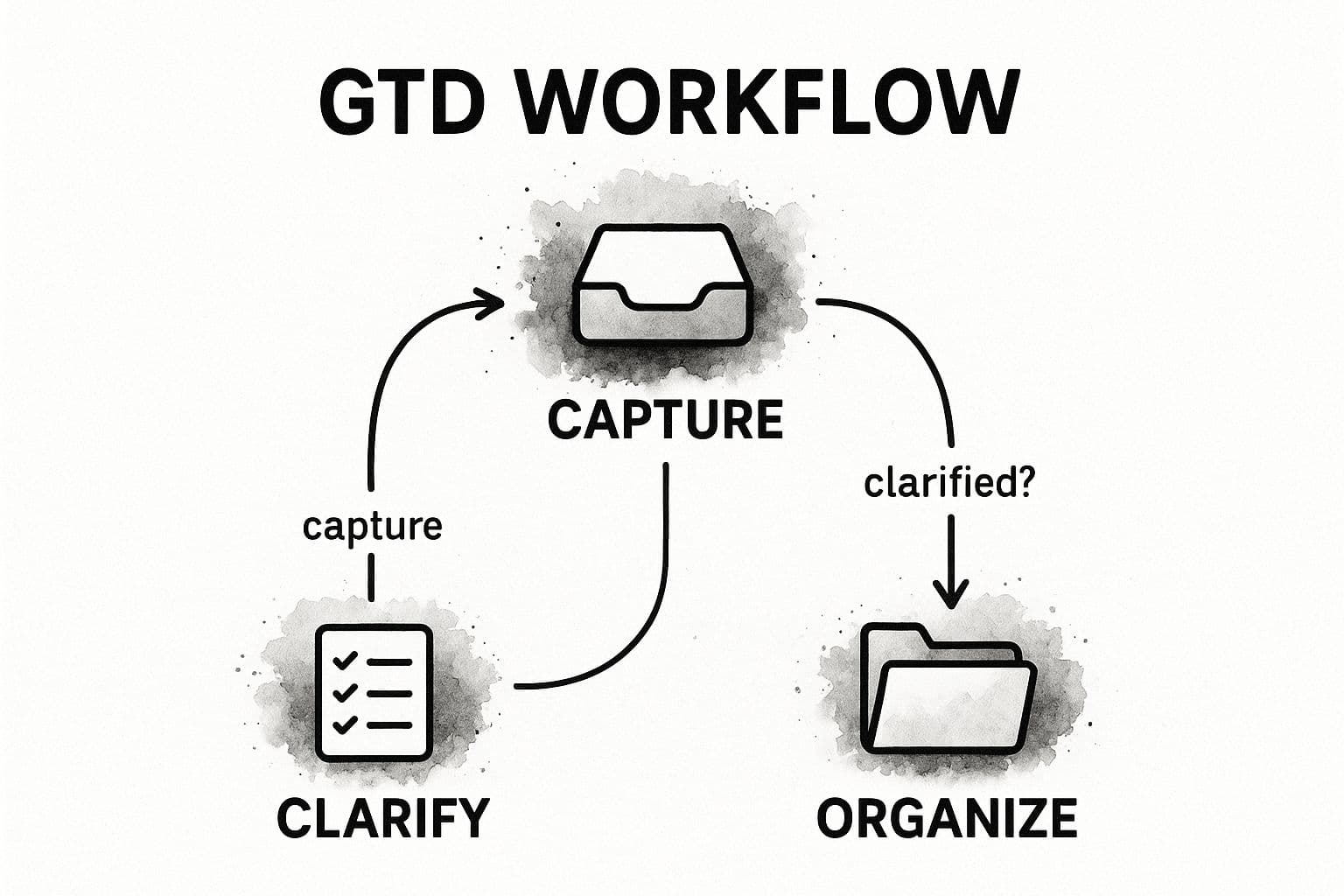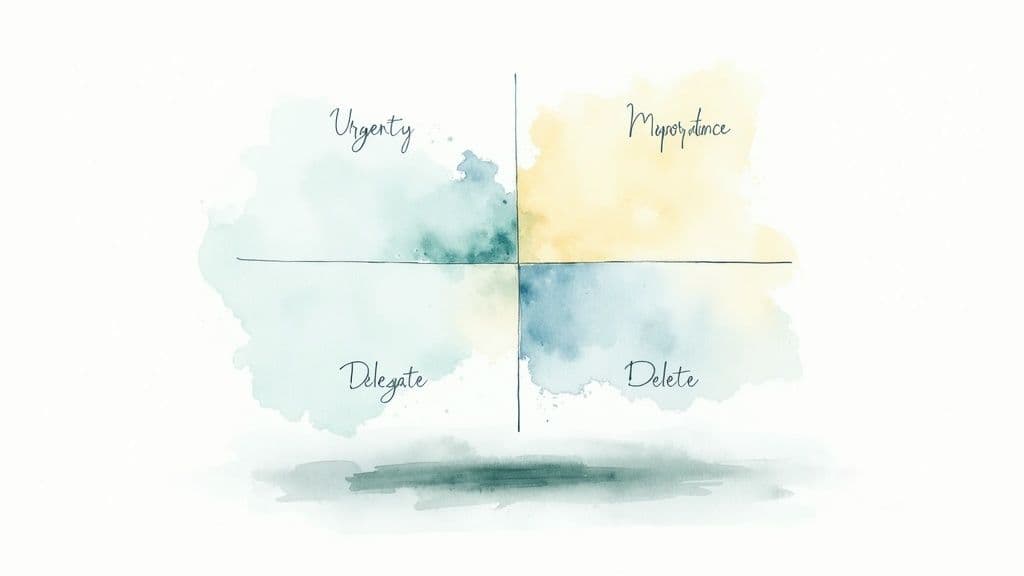Discover effective time management strategies to boost productivity and achieve more in 2025. Learn proven methods to manage your time better today!
July 22, 2025 (4mo ago)
Top 9 Time Management Strategies for Success in 2025
Discover effective time management strategies to boost productivity and achieve more in 2025. Learn proven methods to manage your time better today!
← Back to blog
In a world of constant digital noise and competing priorities, mastering your time is one of the most critical skills for professional success. Many professionals feel perpetually behind, juggling overflowing inboxes and endless task lists. True productivity is not about working harder; it is about working smarter, and effective time management is the key to unlocking that potential. This requires moving beyond a simple to-do list and adopting a more structured approach.
This article provides a comprehensive roundup of nine powerful, battle-tested time management strategies**. We will explore a diverse set of methodologies, including the focused sprints of the Pomodoro Technique, the structured framework of Getting Things Done (GTD), and the high-level prioritization of the Eisenhower Matrix. For a comprehensive overview of various approaches, you can also dive deeper into expert time management strategies for professionals designed to maximize your output.
For each strategy presented here, we will dissect its core principles, highlight its ideal use cases, and outline clear, actionable steps for implementation. Crucially, we will demonstrate how you can leverage a tool like Fluidwave, an AI-driven task management platform, to seamlessly integrate these techniques into your daily routine. By the end of this guide, you will have the knowledge to transform these abstract concepts into tangible results, helping you reclaim control over your schedule, reduce stress, and achieve your most important goals with greater efficiency. Let's begin.
1. Pomodoro Technique
The Pomodoro Technique, developed by Francesco Cirillo in the 1980s, is a cyclical time management strategy designed to enhance focus and prevent mental burnout. It operates on a simple yet powerful principle: work is broken down into short, timed intervals, traditionally 25 minutes long, which are called "pomodoros." Each work interval is followed by a short 5-minute break. This structure leverages the brain's natural ability to maintain high levels of concentration for limited periods, making it an effective method for tackling complex tasks without succumbing to fatigue.

After completing four consecutive pomodoros, you take a longer, more restorative break of 15-30 minutes. This system creates a sustainable rhythm of intense focus followed by deliberate rest, which is crucial for maintaining productivity over an entire workday. It is particularly effective for knowledge workers, software developers managing coding sprints, writers structuring their sessions, or students preparing for exams.
How to Implement the Pomodoro Technique
To begin, choose a single task to focus on. Set a timer for 25 minutes and work exclusively on that task, resisting all distractions. When the timer rings, mark your progress and take a 5-minute break. This break should be a complete disengagement from your work-stretch, grab a glass of water, or simply rest your eyes.
Actionable Tips for Success:
- Plan Your Pomodoros: At the start of your day, list the tasks you need to complete and estimate how many pomodoros each will require. This turns a daunting to-do list into a manageable series of focused efforts.
- Protect Your Intervals: A core rule is that a pomodoro is an indivisible unit of work. If you are interrupted during a 25-minute session, the pomodoro is considered void. Pause the timer, address the interruption, and restart the pomodoro later. This trains you to defer distractions.
- Use a Dedicated Timer: Whether it's a physical kitchen timer or a digital app, using an external timer is more effective than a clock on your computer screen. The physical act of setting it reinforces your commitment to the focused session.
2. Getting Things Done (GTD)
Getting Things Done (GTD), created by productivity consultant David Allen, is a comprehensive workflow management system. It's one of the most respected time management strategies because it focuses on moving planned tasks and projects out of your mind and into an external system. The core principle is that your brain is for having ideas, not holding them. By capturing everything that commands your attention, you can clear mental clutter and focus entirely on executing the task at hand.
This system is built on a five-step process: capture, clarify, organize, reflect, and engage. Its goal is to provide you with a trusted system for all your commitments, big and small. GTD is particularly powerful for executives managing multiple high-stakes projects, entrepreneurs coordinating diverse business operations, or project managers who need to track complex, interconnected workflows without losing sight of the details. It ensures that nothing falls through the cracks.
How to Implement Getting Things Done (GTD)
The first step in implementing GTD is to capture everything, from major project ideas to minor to-dos like "buy milk," into an inbox. This can be a physical tray, a notebook, or a digital tool like Fluidwave’s task management suite. Once captured, you process each item by asking a series of questions to decide what action is needed. Is it actionable? If yes, what is the very next physical action required? If it takes less than two minutes, do it immediately.
The following infographic illustrates the first three foundational stages of the GTD workflow: capturing ideas, clarifying their meaning, and organizing them for action.

This visual flow underscores how a disorganized "inbox" of raw inputs is systematically transformed into a structured set of actionable tasks.
Actionable Tips for Success:
- Do a Weekly Review: The Weekly Review is non-negotiable in GTD. Set aside time once a week to review all your lists, clear your inboxes, and get current. This maintains the integrity of your system and builds trust in it.
- Focus on Next Actions: Instead of being overwhelmed by large projects, define the single, physical "next action" required to move it forward. This makes even the most daunting goals approachable.
- Use Contexts: Organize your tasks by the context required to complete them, for example,
@office,@calls, or@computer. This allows you to see a list of actions you can take right where you are, with the tools you have. - Start Simple: Don't over-engineer your system at the beginning. Use simple tools you are comfortable with and add complexity only as needed. To dive deeper into this and other frameworks, explore our guide on personal productivity systems.
3. Eisenhower Matrix (Priority Matrix)
The Eisenhower Matrix is a powerful decision-making framework for prioritizing tasks based on their urgency and importance. Attributed to U.S. President Dwight D. Eisenhower and popularized by Stephen Covey, this method helps you distinguish between activities that are merely urgent and those that are truly important, a critical skill in effective time management strategies. It organizes your to-do list into a four-quadrant grid, guiding you to focus on what genuinely moves the needle toward your long-term goals rather than just reacting to daily fires.

This approach is highly effective for leaders and managers who must constantly balance high-stakes strategic initiatives with immediate operational demands. By categorizing tasks into "Do First," "Schedule," "Delegate," and "Delete," the matrix provides a clear, visual action plan. It prevents important but non-urgent activities, like strategic planning or professional development, from being perpetually overshadowed by more immediate but less significant demands. This method forces a conscious evaluation of your priorities, ensuring your efforts are invested wisely. For a deeper dive, you can explore detailed guides on how to prioritize tasks at work on fluidwave.com.
How to Implement the Eisenhower Matrix
Begin by listing all your tasks. Evaluate each one against two criteria: its urgency (Does it require immediate attention?) and its importance (Does it contribute to my long-term goals?). Place each task into one of the four quadrants:
- Quadrant 1 (Urgent & Important): Do these tasks immediately. Examples include crises, pressing deadlines, and critical problems.
- Quadrant 2 (Not Urgent & Important): Schedule these tasks. This is where strategic growth happens: planning, relationship-building, and new opportunities.
- Quadrant 3 (Urgent & Not Important): Delegate these tasks. These are often interruptions, some meetings, or activities that don't align with your key responsibilities.
- Quadrant 4 (Not Urgent & Not Important): Delete or minimize these activities. They are time-wasters and distractions.
Actionable Tips for Success:
- Focus on Quadrant 2: The key to sustained success is spending most of your time on important, non-urgent tasks. Proactively scheduling these prevents them from becoming future crises.
- Define 'Important': Create specific criteria for what "important" means to you or your team. This ensures consistency and prevents tasks from being miscategorized based on emotion.
- Be Ruthless with Quadrant 4: Actively identify and eliminate activities that offer no value. This might include scrolling social media, unnecessary meetings, or sorting low-priority emails.
- Review Regularly: Your matrix is a dynamic tool. Review and adjust it on a weekly or even daily basis to reflect changing priorities and new information.
4. Time Blocking
Time blocking is a powerful scheduling method where you assign a specific block of time to every task in your day. Instead of working from a reactive to-do list, you proactively schedule appointments with yourself on your calendar for each activity. This approach, championed by high-performers like Cal Newport and Bill Gates, transforms your intentions into a concrete plan, treating your focused work sessions with the same importance as a meeting with a key stakeholder.

This strategy forces you to confront the reality of how much time you have and make deliberate choices about how to use it. By allocating specific slots for deep work, shallow tasks, and even breaks, you create a structured yet flexible framework for your day. It is one of the most effective time management strategies for anyone seeking to regain control of their schedule, from software engineers balancing coding and meetings to entrepreneurs separating strategic planning from daily operations.
How to Implement Time Blocking
To get started with time blocking, review your task list and estimate the time required for each item. Then, open your calendar and begin assigning these tasks to specific time slots. A software engineer might block 9-11 AM for "Deep Work: Coding New Feature," 11-11:30 AM for "Code Review," and 2-3 PM for "Team Sync Meeting." This visual schedule provides a clear roadmap for the day.
Actionable Tips for Success:
- Color-Code Your Blocks: Use different colors for different types of activities (e.g., blue for deep work, green for meetings, yellow for administrative tasks). This provides an at-a-glance overview of your day's structure.
- Schedule Buffer Time: Don't schedule tasks back-to-back. Include 10-15 minute buffer blocks between major activities to allow for transitions, unexpected overruns, or a quick mental reset.
- Review and Adapt: Your initial time estimates might be inaccurate. At the end of each day or week, review your blocked schedule against what you actually accomplished and adjust your future blocks for greater realism. This iterative process is key to mastering the technique.
5. Eat the Frog
Popularized by author Brian Tracy, the "Eat the Frog" principle is one of the most powerful time management strategies for overcoming procrastination and ensuring high-impact work gets done. The concept, inspired by a Mark Twain quote, suggests you should tackle your most challenging, important, or dreaded task first thing in the morning. This single, significant task is your "frog." By completing it before anything else, you guarantee that the rest of your day feels more manageable and productive.
This approach capitalizes on peak morning willpower and cognitive energy. When you start your day by accomplishing your most difficult task, it creates a powerful sense of momentum and accomplishment that carries you through less demanding activities. It is an excellent strategy for professionals who face high-stakes tasks, such as entrepreneurs finalizing strategic plans, sales leaders making difficult prospect calls, or developers working on a complex piece of code.
How to Implement the Eat the Frog Method
First, you must accurately identify your "frog" for the next day. This isn't necessarily the longest task, but the one that will have the greatest positive impact on your goals and the one you are most likely to procrastinate on. Once identified, you commit to working on it exclusively as the first professional action of your day, before checking emails or attending to minor requests.
Actionable Tips for Success:
- Identify Your Frog the Night Before: End your workday by determining what your most important task is for the following morning. This eliminates decision fatigue when you start your day and allows you to dive right in.
- Create a Distraction-Free Zone: Your "frog-eating" time is sacred. Close unnecessary browser tabs, put your phone on silent, and signal to colleagues that you are in a deep work session. Protect this time fiercely.
- Break Down a Giant Frog: If your frog seems too large and overwhelming to complete in one session, break it down into smaller, actionable steps. Then, commit to eating the very first part of it. The goal is to make meaningful progress.
6. The 80/20 Rule (Pareto Principle)
The 80/20 Rule, also known as the Pareto Principle, is a powerful time management strategy based on the observation that roughly 80% of outcomes result from only 20% of efforts. Originally identified by economist Vilfredo Pareto, this principle suggests that we can achieve significantly more by identifying and focusing on the vital few activities that yield the most substantial results, rather than spreading our energy thinly across the trivial many. This approach transforms productivity by shifting focus from being busy to being effective.
Applying this principle means you stop treating all tasks as equal. Instead, you critically evaluate where your time and energy are best invested. For example, a sales team might find that 20% of their clients generate 80% of revenue, or a software developer might discover that 20% of bugs cause 80% of system crashes. By strategically allocating resources to these high-impact areas, individuals and teams can maximize their output with less effort, making it one of the most leveraged time management strategies available.
How to Implement the 80/20 Rule
Start by analyzing your tasks and their corresponding outcomes. The goal is to separate high-impact activities from low-impact ones. This requires a reflective and data-driven approach to your work. Identify the 20% of your efforts that are producing 80% of your desired results and re-prioritize your to-do list accordingly.
Actionable Tips for Success:
- Analyze Your Activities: At the end of each week, list your major accomplishments and the key activities that led to them. Identify patterns to pinpoint which tasks consistently deliver the most value.
- Focus on High-Impact Tasks: Dedicate your most productive hours to the 20% of tasks you identified as critical. Push lower-impact activities to less productive times or consider delegating or eliminating them.
- Eliminate or Delegate: Be ruthless in cutting out tasks that consume time but produce little to no significant results. If a task is necessary but low-impact, delegate it to free up your focus for what truly matters. This continuous refinement is key to mastering the 80/20 rule.
7. Two-Minute Rule
The Two-Minute Rule, popularized by productivity consultant David Allen in his "Getting Things Done" (GTD) methodology, is a beautifully simple yet powerful time management strategy. Its core principle is straightforward: if a new task or action takes less than two minutes to complete, you should do it immediately rather than deferring it or adding it to your to-do list. This approach prevents small, administrative tasks from accumulating and creating a sense of overwhelming clutter in your workflow.
By handling these quick items on the spot, you reduce mental overhead and build momentum. The friction of starting new work is often the biggest barrier to productivity. The Two-Minute Rule acts as a gateway habit, making it easier to start and maintain a productive flow. It is exceptionally useful for professionals who deal with a constant stream of communications and small administrative duties, such as responding to a quick email, filing a document, or confirming an appointment.
How to Implement the Two-Minute Rule
To apply this rule, you must first develop the habit of estimating task duration. When a new task appears, ask yourself, "Will this take less than two minutes?" If the answer is yes, execute it right away. For example, instead of letting a query from a colleague sit in your inbox, type out a brief response. Instead of leaving a document on your desktop to file later, move it to the correct folder immediately.
Actionable Tips for Success:
- Be Realistic, Not Optimistic: Accurately gauge if a task truly fits within the two-minute window. Misjudging can lead you to start a more complex task, derailing your planned work.
- Protect Deep Work: The rule should not be an excuse to interrupt focused, deep work sessions. When you are in a flow state, capture the quick task on a notepad and address it during a designated break or transition period.
- Use During Transitions: The moments between meetings or after completing a major task are perfect opportunities to apply the Two-Minute Rule. Use this time to clear out several small items at once.
- Set Clear Boundaries: While effective, this strategy requires discipline. Avoid letting it turn your day into a series of reactive, two-minute interruptions. The goal is to manage small tasks efficiently, not to let them manage you.
8. Deep Work
Deep Work, a concept popularized by author Cal Newport, is the practice of focusing without distraction on a cognitively demanding task. This approach involves dedicating sustained, uninterrupted periods to high-value activities that require intense concentration. By eliminating shallow work and constant connectivity, you can produce higher-quality outcomes in less time, making it one of the most impactful time management strategies for knowledge workers.
This method is built on the principle that the ability to concentrate intensely is a skill that can be trained. It involves creating a deliberate practice around minimizing distractions to allow your cognitive capabilities to operate at their peak. This is ideal for programmers solving complex architectural problems, writers drafting a manuscript, or consultants developing a strategic plan. The goal is to move beyond mere busyness and engage in work that truly drives progress. For those aiming to master concentrated effort, exploring additional strategies for deep work and presence can provide significant benefits.
How to Implement Deep Work
Implementing Deep Work begins with scheduling it like any other important appointment. You must intentionally block out time in your calendar dedicated solely to focused activity. During these blocks, it is critical to create an environment that is completely free from interruptions like email notifications, social media, and non-essential meetings.
Actionable Tips for Success:
- Schedule Your Sessions: Identify your most cognitively demanding tasks and block out 90-120 minute "Deep Work" sessions in your calendar. Treat these blocks as non-negotiable meetings.
- Create a Ritual: Develop a pre-work ritual to signal to your brain that it's time to focus. This could be as simple as clearing your desk, putting on noise-canceling headphones, or making a specific type of coffee.
- Embrace Boredom: A key part of building focus is learning to be comfortable without constant stimulation. Avoid pulling out your phone every time you have a spare minute; let your mind wander or be still instead. Learn more about how to improve your focus at work on fluidwave.com.
9. Task Batching
Task Batching is a productivity strategy centered on grouping similar, small tasks together and executing them in a single, dedicated time block. Popularized by authors like Tim Ferriss, this method directly combats the inefficiencies of context switching. Instead of constantly shifting your mental gears between different types of activities, you maintain a single cognitive mode for an extended period, which conserves mental energy and boosts overall output.
This approach leverages the concept of cognitive momentum. Every time you switch from one task type to another, such as moving from writing a report to answering emails, your brain requires time to adjust. Task batching minimizes these transitional costs. It is particularly effective for managing recurring, low-effort activities like responding to communications, processing invoices, or performing routine data entry, allowing you to clear your plate of administrative clutter efficiently.
How to Implement Task Batching
Begin by identifying recurring tasks in your workflow that can be grouped by nature. Common categories include administrative work, communication, research, or creative content production. Instead of addressing these tasks as they appear, schedule specific blocks of time to handle them all at once. For example, dedicate a 30-minute block in the morning and afternoon solely for checking and replying to emails.
Actionable Tips for Success:
- Identify Your Batches: Analyze your to-do list for patterns. Do you make several phone calls a day? Group them. Do you handle multiple invoices? Batch them. Common batches include all your calls, all your emails, or all your social media updates.
- Align Batches with Energy Levels: Schedule demanding batches, like writing or strategic planning, for your peak productivity hours. Reserve lower-energy times for more routine tasks like filing paperwork or responding to non-urgent messages.
- Set Firm Time Limits: Use a timer to define the start and end of each batch session. This creates a sense of urgency and prevents a single batch from overflowing into time reserved for other important work. This is a key part of making task batching one of the most effective time management strategies.
Time Management Strategies Comparison
| Method | Implementation Complexity 🔄 | Resource Requirements ⚡ | Expected Outcomes 📊 | Ideal Use Cases 💡 | Key Advantages ⭐ |
|---|---|---|---|---|---|
| Pomodoro Technique | Low 🔄 | Low ⚡ | Improved focus, reduced fatigue 📊 | Tasks requiring sustained focus, studying, creative work | Boosts concentration, prevents burnout, easy tracking |
| Getting Things Done | High 🔄 | Medium ⚡ | Reduced mental clutter, better follow-through 📊 | Complex roles, managers, knowledge workers | Comprehensive system, scalable, stress reduction |
| Eisenhower Matrix | Low to Medium 🔄 | Low ⚡ | Better prioritization, focused work 📊 | Leaders, strategic planners, priority management | Simple, strategic, time-waster identification |
| Time Blocking | Medium 🔄 | Medium ⚡ | Realistic scheduling, better time use 📊 | Knowledge workers, creatives, executives | Reduces decision fatigue, improves accountability |
| Eat the Frog | Low 🔄 | Very Low ⚡ | Completed high-impact tasks, reduced procrastination 📊 | Procrastinators, morning people, daily priority tasks | Tackles hardest tasks first, builds momentum |
| The 80/20 Rule | Medium 🔄 | Low to Medium ⚡ | Maximized efficiency and results 📊 | Results-focused individuals, business owners | Focuses on vital few, eliminates waste |
| Two-Minute Rule | Very Low 🔄 | Very Low ⚡ | Reduced small task buildup, maintained momentum 📊 | Overwhelmed professionals, admins, busy workers | Simple, reduces decision fatigue, clears clutter |
| Deep Work | High 🔄 | Medium to High ⚡ | High-quality output, skill improvement 📊 | Knowledge workers, researchers, creatives | Intense focus, competitive advantage, quality work |
| Task Batching | Medium 🔄 | Low to Medium ⚡ | Increased efficiency, less context switching 📊 | Busy professionals, entrepreneurs, content creators | Reduces mental fatigue, accurate time estimation |
From Strategy to Action: Building Your Personalized System
Mastering your time is not about finding a single, magical solution. Instead, it’s about becoming a skilled artisan, crafting a personalized system from a toolkit of proven time management strategies. Throughout this guide, we've explored a powerful arsenal of nine distinct methodologies, each offering a unique lens through which to view your tasks, priorities, and energy.
We journeyed from the rhythmic, focused sprints of the Pomodoro Technique to the comprehensive capture-and-organize framework of Getting Things Done (GTD). We learned to separate the urgent from the important with the Eisenhower Matrix and to reclaim our schedules with intentional Time Blocking. These aren't just abstract concepts; they are practical blueprints for transforming chaos into clarity.
The true power, however, lies not in choosing one strategy but in combining them. Your mission, should you choose to accept it, is to move from passive learning to active experimentation. The journey to effective time management is iterative, built on trial, reflection, and adjustment.
Your Action Plan: Forging a Custom Workflow
The path forward begins with a single step. You don't need to overhaul your entire life overnight. The key is to start small, observe the results, and build momentum.
Here is a practical roadmap to begin personalizing your approach:
- Start with One: Select the single strategy that resonated most with you. If you struggle with focus, try the Pomodoro Technique for one afternoon. If you constantly feel busy but not productive, use the Eisenhower Matrix to plan your next day.
- Identify Your 'Frog': For the next three workdays, begin by identifying your single most important task-your 'frog'-and commit to tackling it before anything else. This simple "Eat the Frog" habit can fundamentally change the trajectory of your day.
- Audit Your Time: Spend a day or two simply observing where your time goes. This initial audit will reveal prime candidates for Task Batching (like answering emails) and highlight low-value activities ripe for elimination using the 80/20 Rule.
- Schedule a 'Deep Work' Session: Block out a 90-minute, distraction-free period on your calendar to engage in Deep Work on a cognitively demanding task. Treat this appointment with the same reverence you would a meeting with your most important client.
The goal is not perfection but progress. Notice what energizes you and what feels like a chore. Perhaps Time Blocking feels too rigid, but the Two-Minute Rule clears out your inbox with surprising efficiency. Maybe the full GTD system is overwhelming, but its principle of capturing every idea in a trusted system lifts a massive mental weight.
The True Prize: Beyond Productivity
Ultimately, adopting these time management strategies is about more than just checking off more tasks. It's about creating space. It’s about ending your workday with a sense of accomplishment, not exhaustion. It’s about having the mental and temporal bandwidth to be present with your family, pursue your hobbies, and think strategically about your future.
By moving from a reactive state-constantly battling the tide of incoming requests-to a proactive one, you reclaim your agency. You become the architect of your day, not a victim of it. This shift ensures that your most valuable and non-renewable resource, your time, is invested in the people, projects, and goals that truly matter.
This is the ultimate promise of effective time management: a life of intention, focus, and fulfillment. You now have the strategies; the next step is to take action.
Ready to stop juggling strategies and start building your unified productivity system? Fluidwave is designed to seamlessly integrate these powerful time management strategies into one intuitive platform. Transform theory into action and see what you can achieve by signing up for a free trial at Fluidwave today.
Focus on What Matters.
Experience lightning-fast task management with AI-powered workflows. Our automation helps busy professionals save 4+ hours weekly.